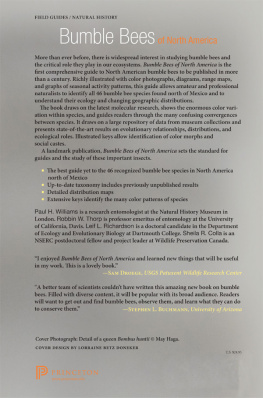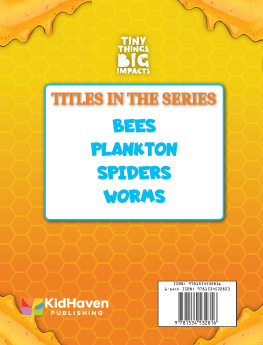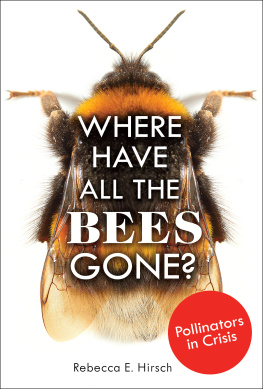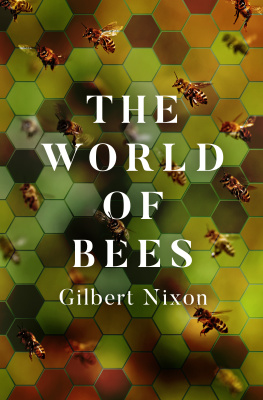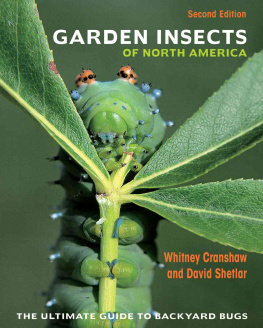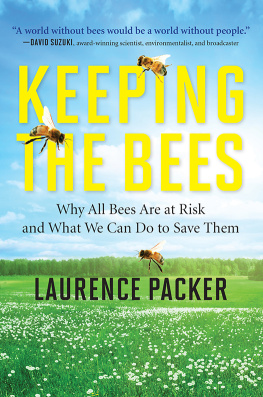An Identification Guide
Bumble Bees of North America
An Identification Guide
Bumble Bees of North America
Paul H. Williams, Robbin W. Thorp,
Leif L. Richardson & Sheila R. Colla

Copyright 2014 by Paul H. Williams, Robbin W. Thorp, Leif L. Richardson, and Sheila R. Colla
Requests for permission to reproduce material from this work should be sent to Permissions, Princeton University Press
Published by Princeton University Press, 41 William Street, Princeton, New Jersey 08540
In the United Kingdom: Princeton University Press, 6 Oxford Street, Woodstock,
Oxfordshire OX20 1TW
press.princeton.edu
All Rights Reserved
ISBN 978-0-691-15222-6
Library of Congress Control Number: 2013945435
British Library Cataloging-in-Publication Data is available
This book has been composed in Minion Pro (main text) and ITC Franklin
Gothic (headings and captions)
Printed on acid-free paper
Designed by D & N Publishing, Baydon, Wiltshire, UK
Printed in China
10 9 8 7 6 5 4 3 2 1
CONTENTS
INTRODUCTION
Everybody likes bumble bees. As colorful and familiar visitors to flowers, these insects have long been appreciated by artists, naturalists, and farmers. The eighteenth-century German pioneer of pollination biology, Christian Konrad Sprengel, made observations of their behavior at flowers, and Charles Darwin went on to describe their importance as pollinators at a time when this ecological function had not been widely recognized. In North America, naturalists have been describing their diversity for more than two centuries, but a great deal remains to be done. This guide is aimed at making that easier.
The value of bumble bees as pollinators of wild and cultivated plants is increasingly appreciated. Each year more than a million commercially produced bumble bee colonies are sold around the world. Most of these colonies are used in greenhouses, where their pollination service is worth more than $10 billion annually. The total value of crop pollination by wild bumble bees is far higher than this. Unfortunately, there is convincing evidence that many species of bumble bees in Asia, North America, South America, and Europe are in decline, in part because of accidental introductions of bee diseases by the bumble bee pollination industry. Several of the species described in this guide were commonly encountered through their ranges just 15 years ago, but they are now exceedingly rare. Others have not been seen for years, and one may now be extinct.
North American bumble bees have been the subject of numerous regional guides, but the only comprehensive revision was by Henry J. Franklin in 1913. In recognizing 59 species north of Mexico, Franklin gave full species status to some taxa now considered parts of a species (e.g., B. californicus, a color pattern of B. fervidus), but did not describe four taxa now generally agreed to be distinct species with ranges in North America (B. caliginosus, B. distinguendus, B. franklini, and B. vandykei). H. E. Milliron started a monograph on the bumble bees of the Western Hemisphere in multiple volumes between 1970 and 1973. He recognized only 34 species north of Mexico, but never completed sections on the subgenera Pyrobombus or Psithyrus. Milliron described a number of the species in this book as subspecies (e.g., he interpreted B. terricola as being composed of two subspecies, B. terricola terricola and B. terricola occidentalis, whereas we recognize these as two separate species). Apparently missing from Millirons work is B. franklini, which he regarded as a variety of B. occidentalis, and completely missing is B. distinguendus, a species well known in the Old World, but only recently discovered in Alaska. Among the larger regional publications since Franklin are those on the bumble bees of the eastern United States (Plath 1934, Mitchell 1962), western United States (Stephen 1957), California (Thorp, Horning, and Dunning 1983), and eastern Canada (Laverty and Harder 1988). Despite our familiarity with bumble bees and the imperative to address their conservation, in North America there remains a need for a comprehensive modern review of the status of bumble bees and an effective identification manual for those interested in them. Franklin openly expressed uncertainty about his separation of some pairs of closely related North American bumble bee taxa as species, and these issues are still debated in the literature. One reason for our uncertainty about bumble bees is that the color patterns of their hair, which include the most obvious characteristics one might use for identification, can be strikingly variable within species and strongly convergent between them. For example, B. bifarius (the so-called Two Form Bumble Bee) occurs throughout western North America in distinctly different red and black color patterns, and at any one site it may bear closer resemblance to other bumble bee species present than to B. bifarius color patterns from other parts of its range. To exacerbate the problem, bumble bees have relatively few distinctive physical characteristics useful for distinguishing one species from another; the bee systematist Charles Michener has called them morphologically monotonous. Thankfully, recent molecular analyses have illuminated this debate. This guide presents some new views of species based on molecular phylogenies (family trees) of bumble bees that we hope will improve understanding of these insects.

The color patterns of Bombus bifarius workers vary around its range.
In addition to describing the distribution and diversity of North American bumble bees, this book is primarily about how to identify them to species. As in some previous guides, we describe hair color patterns in a diagram for each caste (queen or worker), dividing the body into differently colored parts to produce a simplified representation. But for many bumble bee specimens, identification is not possible by use of these color patterns alone. We therefore emphasize the importance of other morphological characteristics, for example the shape of the face and of the male genitalia. Identification of this group of insects is more difficult than is commonly assumed, and experience has shown that there is no substituteeven for expertsfor these more subtle characters. That said, we have attempted to make the process of identifying bumble bees as straightforward as we can, stripping away technical language where possible and presenting a system that specialists and beginners alike should be able to use.
BUMBLE BEE DISTRIBUTION AND DIVERSITY
Bumble bees belong to the insect order Hymenoptera, which includes the bees, ants, wasps, and sawflies. Like other similar insect groups such as Diptera (flies), Coleoptera (beetles), and Lepidoptera (butterflies and moths), the Hymenoptera go through a complete metamorphosis between the larval and adult stages of development. Within this group, bees are essentially hairy wasps, from which they diverged more than 100 million years ago. Bees differ from most living wasp lineages in that plant pollen, rather than animal tissue, provides the protein necessary for larval development, and it is thought that bee diversification tracked the adaptive radiation of flowering plants in the late Cretaceous period. Bees differ from wasps in a number of ways, not only in that they have branched body hairs and other adaptations for harvesting and carrying pollen, but also in having an array of tongue morphologies that facilitate feeding from nectar at flowers of different depths.
Next page
